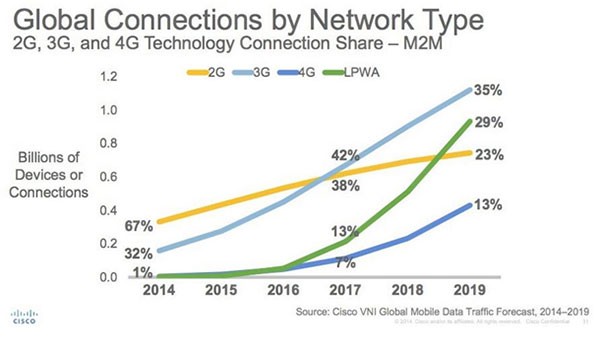The antenna market is experiencing significant growth, with industry projections calling for a far more dramatic increase over the next few years. This article will explore some key antenna market drivers, along with TTI’s strong portfolio of superior antenna manufacturers and solutions. An antenna is a conductor that can transmit, send and receive signals such as microwave, radio, satellite, or Bluetooth. Antennas convert Radio Frequency (RF) fields into Alternating Current (AC) or vice-versa.
Antennas are a key component in all wireless applications and are defined by a technology (Bluetooth, Wi-Fi, Mesh networks to name a few), and will need to operate on a wireless network. It is helpful to have an understanding of the existing wireless networks as they impact the requirements of the antenna and associated radio.
Wireless connections can be easily understood in terms of the network area they cover. There are Personal Area Networks (PANs) that cover short distances in the immediate few meters of a person’s body. These are often for wearable devices such as for fitness or health monitoring. Bluetooth or Bluetooth Low Energy (BLE) is the preferred PAN technology. There are Wireless Local Area Networks (WLANs) covering an area of about the size of a home such as with Wi-Fi. On a larger scale there are Metropolitan (or Neighborhood) Area Networks (MANs) covering a city and lastly Wireless Wide Area Networks (WWANs) are meant for the greatest area and most often provide the backbone connection to the internet cloud often with 4G/LTE. Another fast growing wide area network technology is the Low Power Wireless Access (LPWA) network that is specifically meant for machine to machine connections. LPWA devices cover wide geographic areas with low data rates using very low power networks for longest battery life.
PAN devices such for medical or fitness monitoring frequently use an embedded antenna often made of ceramic. The antennas need high efficiency to ensure transmitted power is used to make a robust wireless connection, and not just waste energy through the creation of needless heat. These traits lead to longer battery life.
On the opposite end of the network spectrum, Wide Area Networks (WAN) often are required to connect to the wireless carriers; (i.e. AT&T, Verizon, Telefonica,) networks. Depending on the devices, the combination of antenna plus radio have strict requirements for Total Radiated Power (TRP) and Total Isotropic Sensitivity (TIS); two parameters that are watched closely by these mobile network carriers. The proper antenna can mean success or failure in getting wireless carrier’s compliance approval. Meanwhile the LPWA networks do not require wireless operator approvals; however the need for low-power consumption environments dictates the use of good antennas. For these cases, the mark of a good antenna might be high gain, rugged weatherproof construction, reliable durable electrical contacts and connectors not affected by time or the elements.
So what is driving the wireless and subsequent antenna growth?
Electronic devices have been on an increase for many years. Personal electronics, home automation, automotive content, medical and industrial equipment are just a few of the drivers behind electronic device growth. As our world continues to increase in the number of electronic devices in the marketplace, there is a need to transfer data. Wires, cables and connectors are a means to transfer data, but wireless products in particular offer efficiency, convenience and an aesthetically clean way to manage the transfer of data, signal, and power. Even if the primary connection is hard-wired, often there is a wireless connection for other reasons such as security backup (think of a thief cutting home phone line) or for disaster situations (when fiber optic or cat-5 cables may be broken).
In addition, much has been said about the IoT (Internet of Things), which assigns IP addresses to physical objects to allow internet communication between connected devices and systems. Most people know that IoT means all kinds of devices will be connected to allow sensing, monitoring and control of those everyday objects. While the IoT is certainly producing growth, wireless is expanding substantially due to the overall convenience for people and businesses.
Cisco Systems predicts that by 2020, 40.5 percent of all global devices and connections will be 4G-capable. The global mobile 4G connections will grow from 1.1 billion in 2015 to 4.7 billion by 2020 at a CAGR of 34 percent. Meanwhile the share of LPWA connections (all M2M) will grow from less than 1percent in 2015 to 7.4 percent by 2020, from 21.6 million in 2015 to 859 million by 2020. (1)
What are some of the most popular antenna types?
Embedded ceramic, embedded helical and internal antenna solutions are widely used in our industry. PCB board-level embedded antennas are an easy to install, low-cost antenna solution. They come in different styles with various performance characteristics: ceramic material provides excellent dielectric properties to “load” the antenna resulting in smaller size than would normally be required. Helical antennas are also a good PCB board-level embedded monopole type of antenna that provides a strong omni-directional pattern. Helicals are excellent at lower frequencies such as the 315 or 433 MHz ISM (instrumentation, scientific and medical) unlicensed frequency bands often being used today in sensors that benefit from good antenna wave propagation at these lower frequencies. Sometimes the proper radiation pattern cannot be achieved with an embedded antenna on a device PCB. The surrounding connectors, RF shields, assembly brackets and other metal objects block the antenna radiation. When this occurs the solution may be an internal antenna such as those connected via a micro-coax cable to allow placement above the circuit board.
TTI suppliers cover the gamut from standard antenna designs to the most demanding custom solutions. TTI offers a full toolbox of antennas for every technology. These antennas are precision-engineered by our supplier partners to the specific use-case and result in best-in-class wireless solutions and end customer experience.
TTI and Pulse Electronics offer antennas that cover all of the PAN, WLAN, MAN, LPWA and WWAN environments. The radio technologies used in them may be any of the following: Wi-Fi, Bluetooth, Bluetooth Low Energy (BLE), unlicensed ISM bands, cellular networks including LTE 4G (and older 3G and 2G technologies), Near Field Communication (NFC), GPS and VHF/UHF communications. What sets apart a great antenna like PulseLarsen is that the antennas have higher gain, better efficiency, and other desirable variables. Additionally, the parameters are well defined and properly specified for the user to select the best antenna for the intended environment. Moreover, the performance is repeatable, as Pulse owns its factories and has total control of processes and raw material vendors. This plus a strong quality control system and 100 percent testing ensures the customer gets what they expect and need.
TTI and Yageo provide the market with a multitude of antennas in a wide variety of styles and compositions. Yageo focuses on high quality antennas that result in enhanced signal reception and extended battery performance while reducing system noise. Enhanced antenna performance is a good way to extend battery life and antennas with higher reception quality make less use of the power amplifier.
API Technologies utilizes standard RF Antenna design software packages along with proprietary software to expertly design custom antenna solutions. TTI and API Technologies supply customers with several antenna compositions including Patch, Cavity Backed, Helical, High-Gain Planar Array, Magnetic Dipole, along with Passive and Active assemblies.
TTI also supports chip antennas, RFID (Radio Frequency Identification), and NFC coils with Murata, Panasonic, TDK, Molex, Phoenix Contact and Vishay.
(1) Source: Cisco VNI Mobile, 2016


